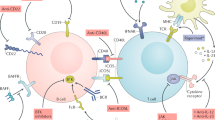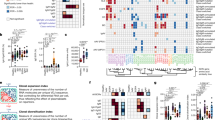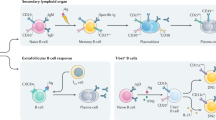Abstract
B cells appear to have a central role in the immunopathogenesis of rheumatoid arthritis (RA) and systemic lupus erythematosus (SLE); both autoantibody production and B-cell anomalies are characteristic of these diseases. With the recent availability of biologic agents that can deplete B cells or block their function in vivo, it has become possible to target B cells therapeutically. Evidence strongly suggests that novel B-cell targeting agents are effective. In addition, the mechanistic specificity of B-cell targeted approaches, combined with the ability to test them in large randomized controlled trials, will provide an unprecedented opportunity to study the precise roles of B cells in the immunopathogenesis of RA and SLE. The largest volume of information is available for rituximab, a chimeric monoclonal antibody that depletes B cells by binding to the CD20 cell-surface antigen. Information from multiple investigator-sponsored trials and from off-label use suggests efficacy of this antibody in RA, SLE, and other autoimmune syndromes. Randomized controlled trials have also provided solid evidence for the efficacy of rituximab in RA and are ongoing in SLE. Other therapeutic agents supported by controlled data include cytotoxic T-lymphocyte-associated protein 4 immunoglobulin and antibodies against the interleukin-6 receptor and the B-cell survival molecule BLyS. Additional agents and targets are in earlier stages of development. The concerns about infectious complications have so far not proven to be justified. We can reasonably expect important advances in the understanding and treatment of RA and SLE in the next 5–10 years, as B-cell targeting methods become more widespread and sophisticated.
Key Points
-
B cells are important in the pathogenesis of rheumatoid arthritis (RA) and systemic lupus erythematosus (SLE), not only because they produce autoantibodies, but also because of their role in anomalous immunoregulation
-
The availability of a B-cell-depleting therapy (rituximab) has greatly facilitated B-cell targeted trials in SLE and RA; efficacy has been demonstrated in randomized controlled trials in RA, but evidence of rituximab's efficacy in SLE is, so far, anecdotal
-
Other approaches to B-cell targeting include anticytokine and anti-B cell-surface molecule techniques, as well as blockade of costimulatory signals
-
Perhaps surprisingly, recurrent infections have not been a safety issue; given the biologic effectiveness of these B-cell targeting agents, however, ongoing vigilance will be essential
-
We hope to learn more about the roles of B cells in RA and SLE by the use of these agents; it will be particularly important that mechanistic studies accompany randomized controlled trials in this area
This is a preview of subscription content, access via your institution
Access options
Subscribe to this journal
Receive 12 print issues and online access
$209.00 per year
only $17.42 per issue
Buy this article
- Purchase on Springer Link
- Instant access to full article PDF
Prices may be subject to local taxes which are calculated during checkout

Similar content being viewed by others
References
Eisenberg R (2005) Do autoantigens define autoimmunity or vice versa? Eur J Immunol 35: 367–370
Slifka MK and Ahmed R (1996) Long-term humoral immunity against viruses: revisiting the issue of plasma cell longevity. Trends Microbiol 4: 394–400
Keystone E (2005) B cell targeted therapies. Arthritis Res Ther 7 (Suppl 3): S13–S18
Yurasov S et al. (2005) Defective B cell tolerance checkpoints in systemic lupus erythematosus. J Exp Med 201: 703–711
Samuels J et al. (2005) Impaired early B cell tolerance in patients with rheumatoid arthritis. J Exp Med 201: 1659–1667
Schroder AE et al. (1996) Differentiation of B cells in the nonlymphoid tissue of the synovial membrane of patients with rheumatoid arthritis. Proc Natl Acad Sci USA 93: 221–225
Takemura S et al. (2001) T cell activation in rheumatoid synovium is B cell dependent. J Immunol 167: 4710–4718
Odendahl M et al. (2000) Disturbed peripheral B lymphocyte homeostasis in systemic lupus erythematosus. J Immunol 165: 5970–5979
Swaak A and van den Brink HG (1996) Case report: common variable immunodeficiency in a patient with systemic lupus erythematosus. Lupus 5: 242–246
Eisenberg RA et al. (1994) The role of B cell abnormalities in the systemic autoimmune syndromes of lpr and gld mice. Semin Immunol 6: 49–54
Chan OT et al. (1999) A novel mouse with B cells but lacking serum antibody reveals an antibody-independent role for B cells in murine lupus. J Exp Med 189: 1639–1648
Lipsky PE (2001) Systemic lupus erythematosus: an autoimmune disease of B cell hyperactivity. Nat Immunol 2: 764–766
Grillo-López AJ et al. (1999) Overview of the clinical development of rituximab: first monoclonal antibody approved for the treatment of lymphoma. Semin Oncol 26 (Suppl 14): 66–73
Tedder TF and Engel P (1994) CD20: a regulator of cell-cycle progression of B lymphocytes. Immunol Today 15: 450–454
O'Keefe TL et al. (1998) Mice carrying a CD20 gene disruption. Immunogenetics 48: 125–132
Leandro MJ et al. (2002) Clinical outcome in 22 patients with rheumatoid arthritis treated with B lymphocyte depletion. Ann Rheum Dis 61: 883–888
Leandro MJ et al. (2002) An open study of B lymphocyte depletion in systemic lupus erythematosus. Arthritis Rheum 46: 2673–2677
Stasi R et al. (2001) Rituximab chimeric anti-CD20 monoclonal antibody treatment for adults with chronic idiopathic thrombocytopenic purpura. Blood 98: 952–957
Levine TD and Pestronk A (1999) IgM antibody-related polyneuropathies: B-cell depletion chemotherapy using rituximab. Neurology 52: 1701–1704
Specks U et al. (2001) Response of Wegener's granulomatosis to anti-CD20 chimeric monoclonal antibody therapy. Arthritis Rheum 44: 2836–2840
Zaja F et al. (2003) Efficacy and safety of rituximab in type II mixed cryoglobulinemia. Blood 101: 3827–3834
Levine TD (2005) Rituximab in the treatment of dermatomyositis: an open-label pilot study. Arthritis Rheum 52: 601–607
Zecca M et al. (2003) Rituximab for the treatment of refractory autoimmune hemolytic anemia in children. Blood 101: 3857–3861
Edwards JC et al. (2004) Efficacy of B-cell-targeted therapy with rituximab in patients with rheumatoid arthritis. N Engl J Med 350: 2572–2581
Edwards JC and Cambridge G (2001) Sustained improvement in rheumatoid arthritis following a protocol designed to deplete B lymphocytes. Rheumatology (Oxford) 40: 205–211
Emery P et al. (2005) Primary analysis of a double-blind, placebo-controlled, dose-ranging trial of rituximab, an anti-CD20 monoclonal antibody, in patients with rheumatoid arthritis receiving methotrexate (DANCER trial) [abstract]. Ann Rheum Dis 64 (Suppl III): 58
Anolik J et al. (2003) B cell depletion therapy in systemic lupus erythematosus. Curr Rheumatol Rep 5: 350–356
Sfikakis PP et al. (2005) Remission of proliferative lupus nephritis following B cell depletion therapy is preceded by down-regulation of the T cell costimulatory molecule CD40 ligand: an open-label trial. Arthritis Rheum 52: 501–513
Gottenberg JE et al. (2005) Tolerance and short term efficacy of rituximab in 43 patients with systemic autoimmune diseases. Ann Rheum Dis 64: 913–920
Looney RJ et al. (2004) B cell depletion as a novel treatment for systemic lupus erythematosus: a phase I/II dose-escalation trial of rituximab. Arthritis Rheum 50: 2580–2589
van Vollenhoven RF et al. (2004) Biopsy-verified response of severe lupus nephritis to treatment with rituximab (anti-CD20 monoclonal antibody) plus cyclophosphamide after biopsy-documented failure to respond to cyclophosphamide alone. Scand J Rheumatol 33: 423–427
Armstrong DJ et al. (2004) Active systemic lupus erythematosus successfully treated with rituximab and oral steroid. Clin Exp Rheumatol 22: 787–788
Anolik JH et al. (2003) The relationship of FcγRIIIa genotype to degree of B cell depletion by rituximab in the treatment of systemic lupus erythematosus. Arthritis Rheum 48: 455–459
Anolik JH et al. (2004) Rituximab improves peripheral B cell abnormalities in human systemic lupus erythematosus. Arthritis Rheum 50: 3580–3590
Dunham J et al. (2005) A longitudinal analysis of SLE patients treated with rituximab: a comparison of B cell depleters to partial B cell depleters [abstract]. Arthritis Rheum 52 (Suppl 9): S740
Teeling JL et al. (2004) Characterization of new human CD20 monoclonal antibodies with potent cytolytic activity against non-Hodgkin lymphomas. Blood 104: 1793–1800
Herrera L et al. (2000) Immunotoxins against CD19 and CD22 are effective in killing precursor-B acute lymphoblastic leukemia cells in vitro. Leukemia 14: 853–858
Leonard JP et al. (2004) Epratuzumab, a humanized anti-CD22 antibody, in aggressive non-Hodgkin's lymphoma: phase I/II clinical trial results. Clin Cancer Res 10: 5327–5334
Kremer JM et al. (2003) Treatment of rheumatoid arthritis by selective inhibition of T-cell activation with fusion protein CTLA4Ig. N Engl J Med 349: 1907–1915
Sidiropoulos PI and Boumpas DT (2004) Lessons learned from anti-CD40L treatment in systemic lupus erythematosus patients. Lupus 13: 391–397
Pollard KM et al. (2004) Costimulation requirements of induced murine systemic autoimmune disease. J Immunol 173: 5880–5887
Stohl W (2005) BlySfulness does not equal blissfulness in systemic lupus erythematosus: a therapeutic role for BLyS antagonists. Curr Dir Autoimmun 8: 289–304
Nishimoto N et al. (2004) Treatment of rheumatoid arthritis with humanized anti-interleukin-6 receptor antibody: a multicenter, double-blind, placebo-controlled trial. Arthritis Rheum 50: 1761–1769
Tackey E et al. (2004) Rationale for interleukin-6 blockade in systemic lupus erythematosus. Lupus 13: 339–343
Llorente L and Richaud-Patin Y (2003) The role of interleukin-10 in systemic lupus erythematosus. J Autoimmun 20: 287–289
Linnik MD et al. (2005) Relationship between anti-double-stranded DNA antibodies and exacerbation of renal disease in patients with systemic lupus erythematosus. Arthritis Rheum 52: 1129–1137
McGaha TL et al. (2005) Restoration of tolerance in lupus by targeted inhibitory receptor expression. Science 307: 590–593
Mizuno T et al. (2003) Fas-induced apoptosis in B cells. Apoptosis 8: 451–460
Carter RH (2004) B cell signalling as therapeutic target. Ann Rheum Dis 63 (Suppl 2): ii65–ii66
Jego G et al. (2005) Dendritic cells control B cell growth and differentiation. Curr Dir Autoimmun 8: 124–139
Lund FE et al. (2005) Regulatory roles for cytokine-producing B cells in infection and autoimmune disease. Curr Dir Autoimmun 8: 25–54
Zuany-Amorim C et al. (2002) Toll-like receptors as potential therapeutic targets for multiple diseases. Nat Rev Drug Discov 1: 797–807
Hutloff A et al. (2004) Involvement of inducible costimulator in the exaggerated memory B cell and plasma cell generation in systemic lupus erythematosus. Arthritis Rheum 50: 3211–3220
Nakamura T et al. (1992) Heterogeneity of immunoglobulin-associated molecules on human B cells identified by monoclonal antibodies. Proc Natl Acad Sci USA 89: 8522–8526
Cyster JG (2003) Homing of antibody secreting cells. Immunol Rev 194: 48–60
Borland G and Cushley W (2004) Positioning the immune system: unexpected roles for α6-integrins. Immunology 111: 381–383
Kunkel EJ and Butcher EC (2003) Plasma-cell homing. Nat Rev Immunol 3: 822–829
Tobinai K et al. (1998) Feasibility and pharmacokinetic study of a chimeric anti-CD20 monoclonal antibody (IDEC-C2B8, rituximab) in relapsed B-cell lymphoma. The IDEC-C2B8 Study Group. Annals of Oncology 9: 527–534
Edwards JC et al. (2005) B lymphocyte depletion in rheumatoid arthritis: targeting of CD20. Curr Dir Autoimmun 8: 175–192
Edwards JC and Cambridge G (2005) Prospects for B-cell-targeted therapy in autoimmune disease. Rheumatology (Oxford) 44: 151–156
Bearden CM et al. (2005) Rituximab inhibits the in vivo primary and secondary antibody response to a neoantigen, bacteriophage phiX174. Am J Transplant 5: 50–57
Adelman BA et al. (2005) Natalizumab and progressive multifocal leukoencephalopathy. N Engl J Med 353: 432–433
D'Arcy CA and Mannik M (2001) Serum sickness secondary to treatment with the murine-human chimeric antibody IDEC-C2B8 (rituximab). Arthritis Rheum 44: 1717–1718
Tahir H et al. (2005) Humanized anti-CD20 monoclonal antibody in the treatment of severe resistant systemic lupus erythematosus in a patient with antibodies against rituximab. Rheumatology (Oxford) 44: 561–562
Gong Q et al. (2005) Importance of cellular microenvironment and circulatory dynamics in B cell immunotherapy. J Immunol 174: 817–826
Quartier P et al. (2001) Treatment of childhood autoimmune haemolytic anaemia with rituximab. Lancet 358: 1511–1513
Quartier P et al. (online 16 January 2003) Enteroviral meningoencephalitis after anti-CD20 (rituximab) treatment. [Link to original article] (accessed 30 September 2005)
Cragg MS et al. (2005) The biology of CD20 and its potential as a target for mAb therapy. Curr Dir Autoimmun 8: 140–174
Deans JP et al. (2002) CD20-mediated apoptosis: signalling through lipid rafts. Immunology 107: 176–182
Bezombes C et al. (2004) Rituximab antiproliferative effect in B-lymphoma cells is associated with acid-sphingomyelinase activation in raft microdomains. Blood 104: 1166–1173
Author information
Authors and Affiliations
Corresponding author
Ethics declarations
Competing interests
R Eisenberg and D Albert are participating in trials with rituximab and epratuzumab, for which they receive monetary support.
Rights and permissions
About this article
Cite this article
Eisenberg, R., Albert, D. B-cell targeted therapies in rheumatoid arthritis and systemic lupus erythematosus. Nat Rev Rheumatol 2, 20–27 (2006). https://doi.org/10.1038/ncprheum0042
Received:
Accepted:
Issue Date:
DOI: https://doi.org/10.1038/ncprheum0042
This article is cited by
-
Jmjd1c demethylates STAT3 to restrain plasma cell differentiation and rheumatoid arthritis
Nature Immunology (2022)
-
The positive effect of pregnancy in rheumatoid arthritis and the use of medications for the management of rheumatoid arthritis during pregnancy
Inflammopharmacology (2021)
-
Overexpression of Aiolos in Peripheral Blood Mononuclear Cell Subsets from Patients with Systemic Lupus Erythematosus and Rheumatoid Arthritis
Biochemical Genetics (2016)
-
The immunopathology of ANCA-associated vasculitis
Seminars in Immunopathology (2014)
-
Immunoglobulin subtypes predict therapy response to the biologics in patients with rheumatoid arthritis
Rheumatology International (2013)



